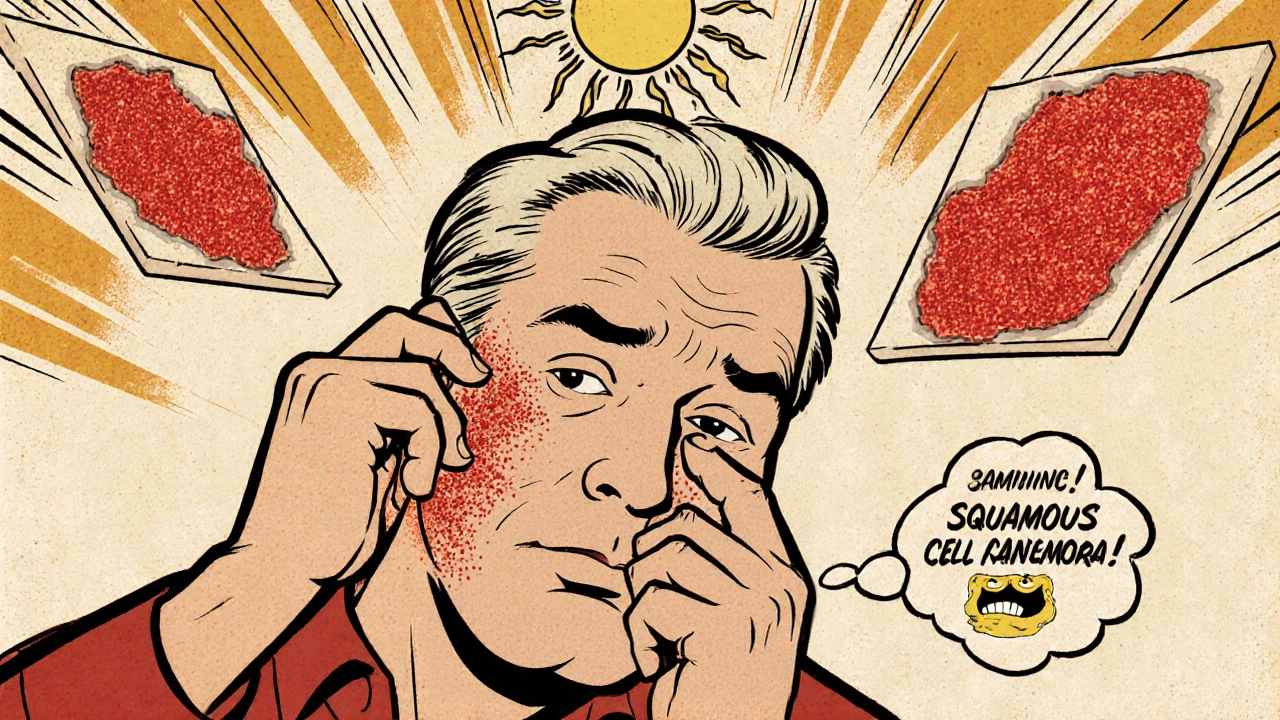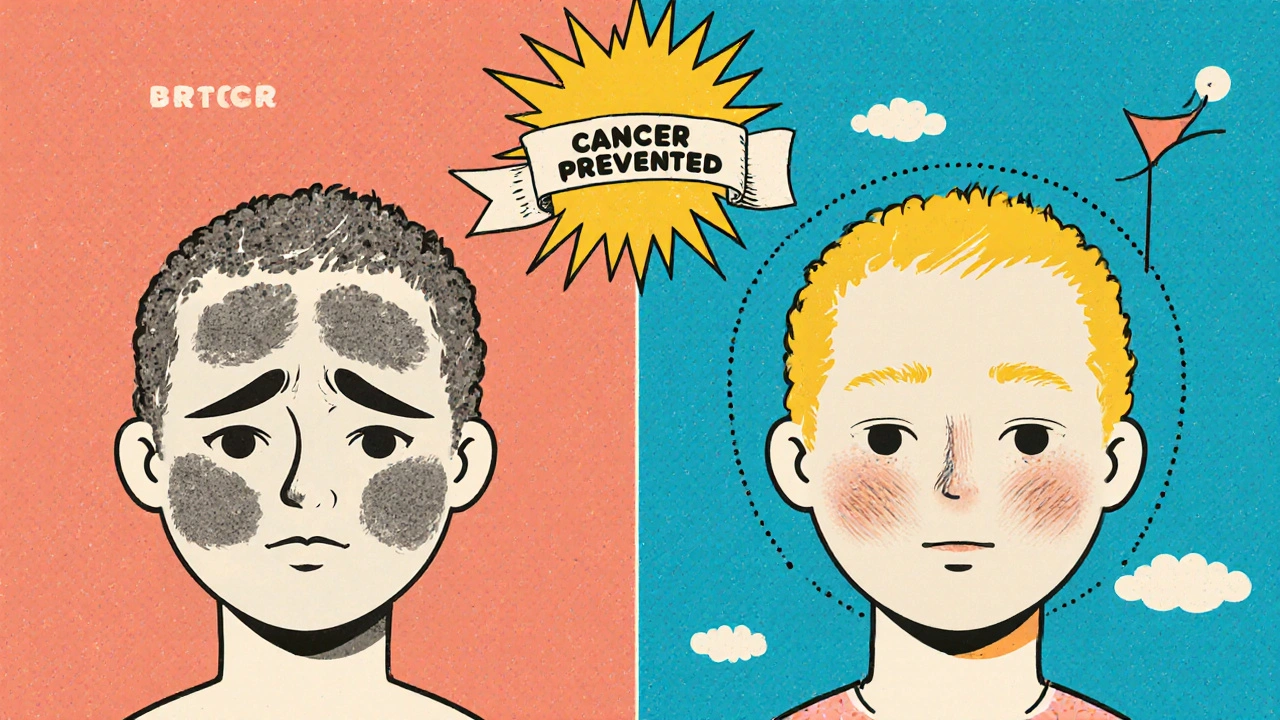Actinic Keratoses: What They Are and How Field Treatments Prevent Skin Cancer
 Nov, 26 2025
Nov, 26 2025
Spot a rough, scaly patch on your cheek, scalp, or the back of your hand? It might not just be dry skin. If you’ve spent years in the sun - even with sunscreen - that patch could be an actinic keratosis, a warning sign your skin is one step away from cancer. These aren’t just blemishes. They’re precancers. And if left alone, up to 15% of people with multiple lesions will develop squamous cell carcinoma, the second most common skin cancer. The good news? When caught early, actinic keratoses are almost always treatable - and preventable.
What Exactly Is an Actinic Keratosis?
An actinic keratosis (AK), also called solar keratosis, is a rough, dry, scaly patch that forms on skin damaged by years of UV exposure. Think of it as your skin’s cry for help. It’s not a rash. It’s not acne. It’s a cellular mistake - a group of abnormal cells in the top layer of your skin that have been mutated by sunlight. These cells haven’t turned into full-blown cancer yet, but they’re on the path. Left unchecked, they can become cutaneous squamous cell carcinoma (SCC), which can spread if ignored. AKs don’t appear overnight. They grow slowly, often over 5 to 10 years. You might not even notice them at first. That’s because they’re more often felt than seen. Run your finger over your nose or forehead - if it feels like sandpaper, that’s a classic sign. The texture is the first clue. Then comes the color: red, pink, brown, gray, or even skin-toned. Some look like small warts. Others are flat and barely visible. In people with darker skin, they can resemble age spots, which makes them easier to miss. They show up where the sun hits hardest: face, ears, scalp (especially if you’re bald), neck, forearms, and backs of hands. About 85% appear on the face and scalp. Dermatologists see them every day. In fact, the American Academy of Dermatology estimates 58 million Americans alone have them. That’s more than half of fair-skinned adults over 40 in sunny regions like Arizona or New Zealand. The numbers are rising. With climate change and longer outdoor seasons, experts predict a 25% increase in AK cases by 2030.Why You Can’t Just Ignore Them
Some people think, “It’s just a patch. It doesn’t hurt. Why treat it?” But that’s the danger. AKs are silent. They don’t always itch or bleed. Yet, research shows 90% of squamous cell carcinomas start as untreated actinic keratoses. The risk isn’t just theoretical. Studies from DermNet NZ and the Cleveland Clinic confirm that 5-10% of individual AKs progress to SCC over 10 years. For people with weakened immune systems - from organ transplants, chemotherapy, or chronic illness - that risk jumps to 25%. Here’s what’s scary: one AK might go away on its own. But if you have 10 or more, your chance of developing skin cancer climbs dramatically. And even if a single lesion disappears, the damage around it remains. That’s called “field cancerization.” Your skin isn’t just damaged where you see the patch - it’s damaged across the whole sun-exposed area. That’s why treating just the visible spots isn’t enough. You need to treat the whole field. Dr. Amanda Oakley, a dermatologist in New Zealand, puts it bluntly: “AKs are an early form of skin cancer.” Not a warning. Not a possibility. A confirmed early stage. Treating them isn’t cosmetic. It’s cancer prevention.How Dermatologists Diagnose Them
Most AKs are diagnosed by sight and touch. A board-certified dermatologist can identify them correctly 95% of the time just by examining the skin. They look for texture, color, size, and location. They use a dermatoscope - a small magnifying tool with light - to see patterns invisible to the naked eye. You don’t need a biopsy for every patch. But if a lesion is thick, tender, bleeding, or growing fast, your doctor will take a sample. That’s because it could be early SCC. The key warning signs are: a lesion over 0.5 cm thick, ulceration, or rapid change. If you’ve had the same rough spot for 6 months and it suddenly feels harder or starts to bleed, get it checked. Many patients don’t realize they have AKs until a doctor points them out. In fact, 78% of people first notice the patches themselves - not because they look bad, but because they feel weird. That’s why dermatologists tell patients to do the “sandpaper test.” After showering, run your fingers over your face, ears, and hands. If something feels gritty or rough, mark it. Bring it up at your next skin check.Field Treatments: The Gold Standard
If you have more than one AK, your doctor won’t just freeze or scrape off the visible ones. They’ll use field-directed treatments. Why? Because the damage is spread out. You’re not just treating lesions - you’re treating the entire sun-damaged zone. There are four main types of field treatments:- Topical creams: These are applied daily for days or weeks. The most common is 5% fluorouracil (5-FU). It kills abnormal cells. Side effects? Redness, peeling, burning - it looks worse before it gets better. But 75-85% of patients clear all visible lesions after 2-4 weeks. Generic versions cost around $120. Then there’s imiquimod, which works by boosting your immune system to attack the bad cells. It takes 16 weeks, but works well for sensitive skin.
- Tirbanibulin (Klisyri): A newer option approved in 2020. It’s a 5-day cream applied once a day. It’s expensive - about $650 per treatment - but ideal for the face because it’s faster and less irritating than 5-FU. Clinical trials showed 44% of patients had complete clearance.
- Photodynamic therapy (PDT): This involves applying a light-sensitive solution (like aminolevulinic acid) to the skin, then exposing it to a special blue or red light. The light activates the solution and destroys abnormal cells. It’s done in-office, takes about 15-30 minutes, and usually needs 1-2 sessions. Clearing rates are 44-75%. It’s great for large areas like the scalp or forehead.
- Chemical peels: Trichloroacetic acid (TCA) at 10-35% strength is painted on the skin to remove the top layers. It’s effective but requires downtime. Used mostly for thick, stubborn lesions.
What the Treatment Feels Like
Let’s be honest - these treatments aren’t pleasant. They cause inflammation. That’s the point. You’re not just applying medicine. You’re triggering your skin’s immune response. The area turns red, swells, crusts, and peels. It can burn like a sunburn on steroids. On Amazon, 42% of reviews for AK creams mention “intense burning.” On forums like HealthUnlocked, patients say, “I cried during week two.” But they also say, “Worth it.” One patient described the 4-week 5-FU treatment as “the worst 28 days of my life” - then added, “I haven’t had a single new lesion in two years.” Doctors know this. That’s why they give you a plan: start slow, use moisturizer, avoid sun, and don’t panic when your skin looks awful. Most reactions peak around day 10-14 and fade by week 4. If the pain is unbearable, pause treatment for a few days. Don’t quit. The goal is to kill the bad cells - not destroy your skin.
Who Needs Treatment - And Who Doesn’t
Not everyone with AK needs aggressive treatment. The British Association of Dermatologists says it’s okay to monitor low-grade, small, and asymptomatic lesions in elderly patients with limited life expectancy. If someone is 85 and has one tiny, flat AK on their arm that doesn’t bother them, watchful waiting might be reasonable. But for most people - especially those with multiple lesions, a history of skin cancer, or who spend time outdoors - treatment is non-negotiable. The FDA requires AK treatments to prove they reduce future skin cancer. Only two topical drugs - 5-FU and ingenol mebutate - have long-term data showing they cut SCC risk by 34-50% over five years. That’s powerful. You’re not just smoothing your skin. You’re lowering your cancer risk.Prevention: The Best Treatment
No treatment works if you keep exposing your skin to UV rays. The Skin Cancer Foundation found that patients who got proper sun protection counseling reduced new AKs by 37% over two years. That’s huge. Here’s what works:- Wear broad-spectrum SPF 30+ daily - even in winter or on cloudy days.
- Use a wide-brimmed hat and UV-blocking sunglasses.
- Avoid direct sun between 10 a.m. and 4 p.m.
- Check your skin monthly. Use a mirror for hard-to-see areas.
- Get a full-body skin exam every year if you’re over 40, have fair skin, or had severe sunburns.
What’s Next for AK Treatment
Research is moving fast. Scientists are studying how the skin’s microbiome - the good bacteria on your skin - might influence AK development. Others are testing drugs that target specific genetic mutations in precancerous cells. One early trial showed a pill that blocked a key cancer pathway reduced AKs by 60% in high-risk patients. But the biggest breakthroughs are in tolerability. New formulations are being developed to reduce burning and peeling. Some are even testing patches instead of creams. The goal? Effective treatment without the misery. For now, the best tools we have are still topical creams, PDT, and vigilance. The message is simple: if your skin feels rough after sun exposure, don’t ignore it. See a dermatologist. Get treated. Prevent the cancer before it starts.Are actinic keratoses the same as skin cancer?
No, actinic keratoses are precancerous - not cancer yet. But they’re the earliest stage of what can become squamous cell carcinoma. About 90% of these cancers start as untreated AKs. Treating them early prevents progression.
Can I treat actinic keratosis at home without seeing a doctor?
No. While some over-the-counter products claim to help, only prescription treatments like 5-fluorouracil, imiquimod, or tirbanibulin have been proven to prevent cancer. Self-diagnosing can lead to missed SCCs. Always get a professional evaluation first.
Do I need to treat every single actinic keratosis?
Not always. If you have one small, flat, non-irritating lesion and are over 80 with no other skin cancers, your doctor might suggest monitoring. But if you have multiple lesions - especially on your face or scalp - field treatment is recommended to prevent future cancers.
How long does it take for field treatments to work?
It depends. Topical creams like 5-FU take 2-4 weeks. Imiquimod takes up to 16 weeks. Tirbanibulin works in just 5 days. Photodynamic therapy usually needs 1-2 sessions spaced weeks apart. Full healing and skin renewal can take 4-8 weeks after treatment ends.
Will the redness and peeling from treatment go away?
Yes. The inflammation is temporary and part of the healing process. Redness, crusting, and peeling usually peak around 10-14 days and fade over the next 2-4 weeks. Your skin will be smoother and healthier afterward. Avoid sun during recovery - your skin is extra sensitive.
Can I get actinic keratoses even if I use sunscreen?
Yes. Sunscreen reduces risk but doesn’t eliminate it. AKs develop from decades of UV exposure - even small amounts add up over time. That’s why people who used sunscreen consistently still get them. That’s why annual skin checks are essential, even if you’re careful.
